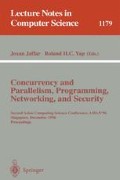Abstract
In this paper, we propose two group-oriented (t, n) blind threshold signature schemes based on the discrete logarithm problem. By these schemes, any t out of n signers in a group can represent the group to sign blind threshold signatures. In our schemes, the size of a threshold signature is the same as the size of an individual signature and the signature verification process is simplified by means of a group public key. Our proposed schemes do not require the assistance of a mutually trusted authority. In addition each signer can select his own private key and the group public key is determined by all the members. The security of our schemes rely on the difficulty of computing discrete logarithm.
Preview
Unable to display preview. Download preview PDF.
References
J. L. Camenisch, J. M. Pivereau and M. A. Stadler, ”Blind signatures based on the discret logarithm problem,” Advances in Cryptology: Proc. of EuroCrypt'94, LNCS 950, pp. 428–432, Springer-Verlag, 1995.
D. Chaum, ”Blind signatures systems,” Advances in Cryptology: Proc. of Crypt'83, Plenum, pp. 153.
D. Chaum, A. Fiat and M. Naor, ”Untraceable electronic cash,” Advances in Cryptology: Proc. of Crypt'88, LNCS 403, pp. 319–327, Springer-Verlag, 1988.
Y. Desmedt and Y. Frankel, ”Threshold cryptosystems,” Advances in Cryptology: Proc. of Crypt'89, LNCS 435, pp. 307–315, Springer-Verlag, 1990.
N. Ferguson, ”Single term off-line coins,” Advances in Cryptology: Proc. of EuroCrypt'93, LNCS 765, pp. 318–328, Springer-Verlag, 1993.
L. Harn, ”Group-oriented (t,n) threshold digital signature scheme and digital multisignature,” IEE Proc. Compu. Digit. Tech., Vol. 141, No. 5, pp. 307–313, September 1994.
L. Harn and Y. Xu, ”Design of generalised ElGamal type digital signature schemes based on discrete logarithm,” Electronic Letters, Vol. 30, No. 24, pp. 205–206, 1994.
W. Juang and C. Lei, ”A collision free secret ballot protocol for computerized general elections,” to appear in Computers & Security (A preliminary version was presented at the 1994 Inter. Computer Symposium, Taiwan, pp. 309–314.)
W. Juang and C. Lei, ”A secure and practical electronic voting scheme for real world environments,” to appear in IEICE Trans. on Fundamentals (A preliminary version was presented at Proc. 6th National Conf. on Informa. Security, Taiwan, pp. 153–160, 1996).
C. S. Laih and L. Harn, ”Generalized threshold cryptosystems,” Advances in Cryptology: Proc. of AsiaCrypt'91, pp. 159–169, 1991.
K. Nyberg and R. A. Rueppel, ”Message recovery for signature schemes based on the discrete logarithm problem,” Advances in Cryptology: Proc. of EuroCrypt'94, LNCS 950, pp. 182–193, Springer-Verlag, 1995.
T. Okamoto, ”A digital multisignature scheme using bijective public-key cryptosystems,” ACM Trans. Computer Systems, Vol. 6, No. 8, pp. 432–441, 1988.
T. Okamoto and K. Ohta, ”Universal Electronic cash,” Advances in Cryptology: Proc. of Crypt'91, LNCS 576, pp. 324–337, Springer-Verlag, 1992.
T. P. Pedersen, ”A threshold cryptosystem without a trusted party,” Advances in Cryptology: Proc. of EuroCrypt'91, LNCS 547, pp. 522–526, Springer-Verlag, 1991.
K. Sako, ”Electronic voting scheme allowing open objection to the tally,” IEICE Trans. fundamentals, Vol. E77-A, No.1, pp. 24–30. 1994.
A. Shamir, ”How to share a secret,” Commun. ACM, Vol. 22, pp. 612–613, 1979.
W. Stallings, ”Network and internetwork security,” Prentice Hall International, pp. 333–340, 1995.
Author information
Authors and Affiliations
Editor information
Rights and permissions
Copyright information
© 1996 Springer-Verlag Berlin Heidelberg
About this paper
Cite this paper
Juang, WS., Lei, CL. (1996). Blind threshold signatures based on discrete logarithm. In: Jaffar, J., Yap, R.H.C. (eds) Concurrency and Parallelism, Programming, Networking, and Security. ASIAN 1996. Lecture Notes in Computer Science, vol 1179. Springer, Berlin, Heidelberg. https://doi.org/10.1007/BFb0027790
Download citation
DOI: https://doi.org/10.1007/BFb0027790
Published:
Publisher Name: Springer, Berlin, Heidelberg
Print ISBN: 978-3-540-62031-0
Online ISBN: 978-3-540-49626-7
eBook Packages: Springer Book Archive

